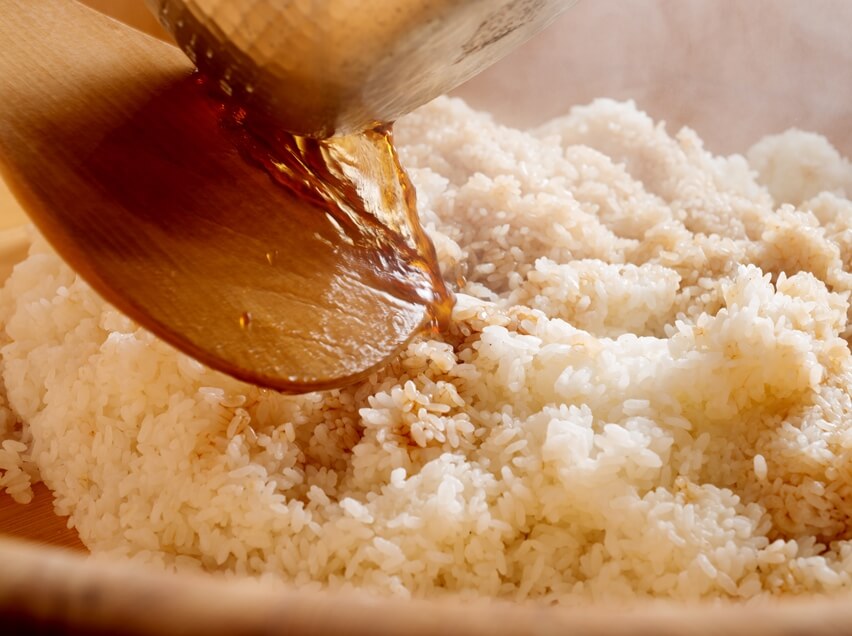
Recently, more and more sushi chefs are using Akazu (Red vinegar).
Vinegar has been around for ages, and records from 5000 B.C. Babylonia shows that things like dates were used to make it. It was around the 4th-5th centuries that vinegar started to be made in Japan. The technology for making vinegar was brought over from China, along with the technology for brewing sake, and from then it was made in the region that we now know as Southern Osaka.
There are said to be thousands of types of vinegar in the world. There is a saying, “Where there is alcohol, there is vinegar,” and fermenting any sake turns it into vinegar. In other words, there is potentially the same number of types of vinegar as types of alcohol, which is a massive number.
Here, we would like to introduce the types of vinegar according to the regulations of the Japanese Agricultural Standard (JAS), and explain the knowledge that you should acquire after that. The second half of this article describes vinegar as the most important seasoning for Edomae sushi, which drastically changes the flavor of the sushi drastically as part of the shari, pickled ingredients, etc. This is your opportunity to gain a deeper understanding of vinegar, with a focus on the vinegar used by sushi restaurants.
According to JAS regulations, vinegar is divided into two categories known as “brewed vinegar” and “synthetic vinegar.” Brewed vinegar is made by first performing alcohol fermentation on a carbohydrate or starch, and then following with acetic acid fermentation. Synthetic vinegar is made by diluting glacial acetic acid made from petroleum and limestone, and adding several food additives such as glutamic acid, succinic acid, and artificial sweeteners. It was used in times of severe food shortages, and it’s very hard to find nowadays.
First, let’s take a brief look at the 10 most typical types of vinegar.
Rice Vinegar(米酢)
If the amount of rice is at least 40 g per liter of vinegar, it is called rice vinegar, even if other ingredients are used. Rice vinegar has a unique sweetness and mellow taste combination of rice. It’s optimum for tasting the vinegar flavor.
When the only major ingredient used is rice, it’s called pure rice vinegar. This moniker requires that at least 120 g of rice per liter of vinegar is used. Pure rice vinegar has good umami and an even better flavor. The higher the rice content, the richer the flavor of rice vinegar.
Black vinegar(黒酢)
There is also brown rice vinegar, which is made from rice that hasn’t been polished. Because it is brewed without removing the germ, it has more nutrients than normal rice vinegar, the flavor and fragrance are more robust, and the color appears to be brown. Therefore it is also called black vinegar. It has between 5 to 20 times the amount of amino acids as normal rice vinegar.
Grain vinegar(穀物酢)
Well-known types of grain vinegar include Sake lees vinegar, which is made from sake lees, Coix lacryma (also known as Job’s tears) vinegar, corn vinegar, etc., and these also require at least 40 g of grain per liter of vinegar to be used in the brewing process. Like black vinegar, Coix lacryma vinegar, which is full of amino acids, is known for its health benefits.
Sake lees vinegar(酒粕酢/粕酢)
This is also known as red vinegar (Akazu). Sake lees vinegar has been made since the end of the Edo period and is unique to Japan. It is made from Sake lees, which has been aged for a long period of time in order to increase the umami aspect, and it is used in the red shari that is often used in Edo-style sushi. It has about double the amount of amino acids of rice vinegar, which are the source of the umami flavor.
Wine vinegar(ブドウ酢/葡萄酢)
Wine vinegar is made by first squeezing grapes to make wine, then fermenting it. It is a staple of western cooking. There are both white and red wine vinegar varieties and this vinegar has a strong fragrance and rich flavor.
Apple vinegar(リンゴ酢)
Like wine vinegar, apple vinegar must be made by fermentation and contains at least 300 g of fruit juice per liter of vinegar. It has a refreshing apple aroma and a fruity taste. Using apple vinegar with salty foods softens the sharp taste of the salt.
Fruit vinegar(果実酢)
Popular fruits for making vinegar besides grapes and apples are persimmons, pears, kiwi, dates, etc.
Brewed vinegar(醸造酢)
Brewed vinegar is a term to collectively refer to brewed vinegar besides rice vinegar, grain vinegar, wine vinegar, apple vinegar and other fruit vinegar. Ingredients could contain a number of things including Sake lees, fruit juice, cereals, etc.
Balsamic Vinegar(バルサミコ酢)
Apparently, balsamico is an Italian word that means “fragrant”. The grape juice that balsamic vinegar is made from is compressed and the juice is boiled down. This is put into a wooden vat and aged for a long time. The fragrance of the wood is infused in the balsamic vinegar in the aging process, and it has a unique fragrance just like the name suggests.
Malt Vinegar(モルトビネガー)
Malt vinegar is made from barley, wheat and corn, in which the barley malt is used to convert them into sugar, which is why it is called malt vinegar. It is the vinegar generally used in England. It tastes like a beer that has been made into vinegar without the bitterness of hops and has a unique flavor and fragrance similar to beer.
The following are 9 effects that vinegar has in cooking that you should remember. Sushi is a great example of how these effects are used skillfully.
1. Salt-reduction effects
Vinegar has the effect of bringing out the flavor of salt, so when used in cooking, sufficient salt flavor is possible even if the amount of salt used is reduced. Therefore, salt content can be reduced by using vinegar and salt together.
In Japanese cuisine, subtle seasoning is essential. Vinegar enhances the perception of saltiness, allowing cooks to reduce the amount of salt while maintaining depth of flavor. This is especially important in vinegared rice (shari), where vinegar compensates for reduced salt and ensures a well-defined taste that complements delicate toppings rather than overpowering them.
2. Create a refreshing flavor
The acidity of vinegar gives dishes a clean, refreshing finish. It lightens rich flavors and gently envelops fats from meat and fish, preventing heaviness on the palate. At the same time, vinegar sharpens the natural flavors of ingredients, allowing their inherent taste to stand out more clearly.
Washoku values lightness and balance. Vinegar provides a refreshing finish that prevents dishes from feeling heavy, particularly in rice dishes and seafood-based preparations. In sushi, the gentle acidity of the rice cleanses the palate, allowing diners to enjoy multiple pieces consecutively without flavor fatigue.
3. Enhances fragrance
The volatility of vinegar enhances fragrance so vinegar refreshingly brings out the fragrance of ingredients. Furthermore, pairing ingredients with a certain type of vinegar can create wonderful fragrances.
4. Eliminate unpleasant odors
When cooking with ingredients that have strong or undesirable odors, vinegar envelopes the smells and mediates them to make a more mellow smell. It suppresses pungent odors and brings out the umami and richness of the ingredients.
Controlling odor is central to Japanese seafood cuisine. Vinegar neutralizes fishy or metallic smells while preserving natural umami. In sushi and vinegared preparations (sunomono), acidity softens harsh notes and refines aroma, allowing the inherent quality of the fish or vegetables to take center stage.
5. Strong permeability into Ingredients
Vinegar is extremely permeable to ingredients. Therefore, even though vinegar has a lighter taste, it soaks into the ingredient and also has the effect of adjusting the flavor. Especially in dishes where meat is boiled, the vinegar gives the meat a deeper layer of flavor.
6. Preservation effect
The acetic acid in vinegar has bactericidal properties that inhibit the growth of spoilage microorganisms. Therefore, when permeated by vinegar, the ingredients can be stored for a longer period of time. Pickles are a good example of this.
7. Flavor adjustment and balance
The fragrance, sweetness, umami and richness of vinegar bring out the good qualities of other seasonings and ingredients and also adjusts the flavors. It can also bring out the flavors of other seasonings.
8. Enhancing and preserving the color of ingredients
Burdock and cauliflower contain pigments (a type of polyphenol) that cause browning and oxidation enzymes (polyphenol oxidase) that trigger browning. When these are cut with a knife, they combine and cause browning. Polyphenols become less prone to oxidation when combined with acidic foods, so soaking ingredients in vinegar water or boiling them in vinegar water can prevent browning. Additionally, boiling ingredients like lotus root or cauliflower in vinegar water helps maintain their white color.
Aesthetics are fundamental in washoku. Vinegar prevents oxidation and discoloration in vegetables such as lotus root and burdock, preserving their clean, white appearance. This visual clarity is essential in sushi and seasonal dishes, where color conveys freshness and craftsmanship.
9. Protein denaturation and firming
Vinegar can denature proteins and solidify them. When cooking fish, adding vinegar solidifies the surface proteins, improving texture and preventing the fish from falling apart, resulting in a neat finish. Vinegar also has the effect of tightening fish meat without heating. If fish is first salted and then pickled in vinegar, the proteins solidify further, making the fish firmer. Conversely, if fish is pickled in vinegar without salting first, the flesh becomes tender and fluffy.
Now we would like to explain the production methods and characteristics of rice vinegar and red vinegar used by sushi restaurants.
Rice vinegar (米酢), as the name suggests, is made from rice. The process starts by washing and steaming the rice, making malted rice, preparing the mash (moromi) and making sake. When acetic acid bacteria is added to this sake, a thin film forms on its surface, indicating the start of the acetic fermentation. It is then left to ferment for several months by the standing fermentation (or static fermentation) method in which leaves the liquid to ferment according to the natural convection current. Or, the air is fed in while swiftly stirring, known as the fast fermentation (or quick fermentation) method, in which rice vinegar can be made with just a few days of fermentation. When rice vinegar is used, the shari is white. Since rice is the source ingredient, the aroma is pleasant and it is characterized by its mellow sweetness.
On the other hand, the source ingredient of red vinegar (赤酢) is only sake lees. It’s the sake lees that is leftover after straining Japanese sake. These sake lees are placed in a wooden vat (or a metal tank) and it is aged for several years at room temperature. This turns the formerly white vinegar to a dark black color due to the Maillard effect (browning due to the reaction of the sugar and amino acids). Water is added to this, where it is dissolved, then filtered and acetic acid bacteria is added to the filtered liquid before aging it, before fermenting it for several more months and aging it for several more months after that. Finally, it is mixed, filtered and sterilized to create the finished “red vinegar” product. When this vinegar is used to make shari, it gives the rice a red color, which is why it came to be called red vinegar. It is characterized by having an acidity that is milder than normal rice vinegar (due to the lower content of diacetyl, which is a type of unpleasant odor) and its strong umami aspect.
Why did the vinegar used in shari switch from red vinegar to rice vinegar?
Vinegar, as an essential ingredient of Edomae-style sushi, was rice vinegar in its earliest form. Later, red vinegar was used, invented by Matazaemon Nakano (中野又左衛門), the founder of Mizkan. That means, when sushi started booming in the Edo period, the shari was red. Since rice was such a valuable commodity, vinegar made from the rice was unattainable for commoners, so as an alternative, cheaper vinegar (red vinegar) made from sake lees was distributed among commoners.
At the time, the traditional Edomae-style method of making sushi was used, making it from only red vinegar and salt, without using sugar. However, currently, rice vinegar is used, and it’s common practice to mix sugar, as well as salt with the vinegar.
The reason is an incident in which some of the rice imported to Japan in 1952, turned yellow due to the proliferation of a harmful mold, becoming what’s known as yellowed rice. The uninformed public brought the red shari into the commotion. Compared to shari made with rice vinegar, shari made with red vinegar has a brown tint to it, so there were many people who caused a fuss, saying it must be yellowed rice. It went beyond that with many people making absurd complaints to sushi restaurants. In the end, most sushi restaurants switched to rice vinegar to quiet down the fuss.
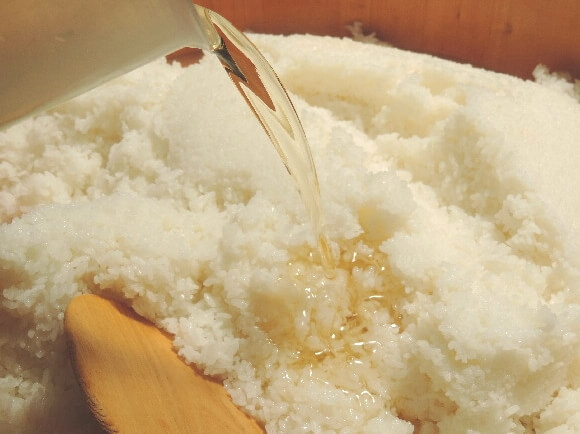 Another reason is that after WWII, sake lees became harder to come by, but the shift in consumer preference was the bigger issue. With help from the rumors of yellowed rice, the faith in white rice was born. That was when sushi entered the “silver shari” era where shari made with white rice was now preferred over shari made with red rice. As if to back that up, according to agriculture, forestry and fisheries survey, red vinegar only makes up 1% of all brewed vinegar. Now, most sushi restaurants use rice vinegar.
Another reason is that after WWII, sake lees became harder to come by, but the shift in consumer preference was the bigger issue. With help from the rumors of yellowed rice, the faith in white rice was born. That was when sushi entered the “silver shari” era where shari made with white rice was now preferred over shari made with red rice. As if to back that up, according to agriculture, forestry and fisheries survey, red vinegar only makes up 1% of all brewed vinegar. Now, most sushi restaurants use rice vinegar.
The Secret History of Mizkan
Sake lees vinegar was first produced by Matazaemon Nakano in Handa City, Aichi Prefecture, between 1804 and 1818, and was shipped to Edo to be used as vinegar for sushi rice. In 1853, the book “Morisadamanko (守貞漫稿),” a history of customs, mentioned that the Nakano family of Owari Province was a symbol of vinegar in Edo.
The Nakano family had originally been in the sake brewing business but lagged behind the more established breweries in the Kansai region, particularly in Nada and Fushimi. When sake production restrictions were completely lifted in 1806, sake from Nada and Fushimi flooded the market, pushing the Nakano family into further hardship. To survive, they applied their sake brewing techniques to produce sake lees vinegar, which coincided with the rise in popularity of nigiri sushi in Edo.
There was a reason why the Nakano family turned their attention to sake lees. Sake lees, which remain after sake is pressed out, were primarily used for pickling in dishes like Nara-zuke, and much of it was used as fertilizer, but its quality was not very good. The Nakano family made effective use of the sake lees produced at their own sake brewery to reduce the cost of vinegar. In addition, the sake lees produced after sake lees vinegar brewing improved in quality as fertilizer. Sake lees vinegar production enabled the simultaneous production of inexpensive vinegar and high-quality fertilizer.
The Nakano family produced sake lees vinegar under brand names such as “Yamabuki (山吹),” “Mitsuban (三ツ判),” “Nakano (中野), ” and “Fuki (富貴).” Among these, “Yamabuki,” named for its Japanese marigold (yamabuki) color when mixed with rice, had a mellow flavor and was specifically made for Edomae-style sushi, particularly for nigiri sushi. It won an award at the first National Industrial Exposition in 1877. Initially, “Mitsuban” was a separate brand from “Yamabuki,” but in the latter half of the Meiji period, it came to refer to the highest quality products of “Yamabuki.” Today, the Nakano family operates under the name Mizkan and produces nearly 70% of Japan’s domestically manufactured vinegar.
Is rice vinegar or red vinegar more suitable for shari?
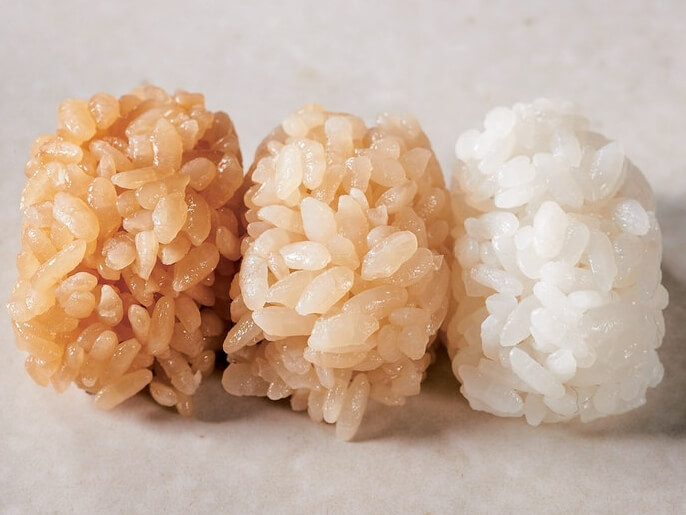 In the past 10 years or so, some sushi restaurants are known to be exclusive have started using red vinegar for their sushi. The red vinegar peculiarly enhances the flavor of the shari. However, setting aside lean tuna and boiled toppings (like conger eel and Nihamaguri) with distinctive flavors, doesn’t necessarily go well with delicate toppings such as white fish and squid. The strong flavor of the red vinegar must be countered, and efforts must be made to deepen the tasting of the topping. For example, increasing the umami of a shellfish by aging it. Using a butcher knife to cut in a way that makes the flavor more obvious. It takes a lot of trial and error to determine the right shari and topping temperatures, and what rice to use. Depending on the chef, they may use a blend of red vinegar and rice vinegar, or use each separately depending on the toppings. Also, almost all the sushi chefs I have asked said that they eventually change to original vinegar rice that differs from where they spent their long apprenticeship. To put it simply, there is no one right way to do it.
In the past 10 years or so, some sushi restaurants are known to be exclusive have started using red vinegar for their sushi. The red vinegar peculiarly enhances the flavor of the shari. However, setting aside lean tuna and boiled toppings (like conger eel and Nihamaguri) with distinctive flavors, doesn’t necessarily go well with delicate toppings such as white fish and squid. The strong flavor of the red vinegar must be countered, and efforts must be made to deepen the tasting of the topping. For example, increasing the umami of a shellfish by aging it. Using a butcher knife to cut in a way that makes the flavor more obvious. It takes a lot of trial and error to determine the right shari and topping temperatures, and what rice to use. Depending on the chef, they may use a blend of red vinegar and rice vinegar, or use each separately depending on the toppings. Also, almost all the sushi chefs I have asked said that they eventually change to original vinegar rice that differs from where they spent their long apprenticeship. To put it simply, there is no one right way to do it.
Now we’ll explain the particular vinegar used by famous restaurants.
Apparently, there are over 100 vinegar manufacturers in Japan. The following are the manufacturers preferred by most famous restaurants.
We’ve mentioned it before, but over 90% of the vinegar used at sushi restaurants is rice vinegar. Only a small number of premium sushi restaurants use Akazu (Sake lees vinegar). Even though there are many types of rice vinegar, the vinegar used to make sushi rice and the vinegar used to marinate sushi toppings are separate. Generally, a cheaper vinegar with alcohol and other additives is used to marinate sushi toppings. Also, some restaurants use rice vinegar for the sushi rice and Akazu for marinating. There are even some restaurants that use a blend of vinegars including black vinegar and fruit vinegar. Finally, there are also restaurants that use both rice vinegar and Akazu for sushi rice, the main constituent of sushi. Naturally, there are a variety of these types of vinegar used.
In this section we will introduce vinegar manufacturers based on Akazu and Rice vinegar categories. However, the information presented here is limited to Edomae sushi restaurants and does not necessarily apply to Kansai or Kyushu sushi.
The main vinegar manufacturers in Kanto are Yokoi Vinegar and Kisaichi Vinegar. Manufacturers in the Chubu (central) region include Mizkan and Uchibori Vinegar while Kyoto’s main manufacturers are Iio Jozo and Murayama Zousu. Either the Akazu or rice vinegar of these six manufacturers make up the majority of vinegar used in Edomae sushi restaurants.
The majority of restaurants use Mizkan, which was the first manufacturer to make Akazu. However, a rice vinegar called Shiragigu (白菊) has been taking Japan by storm. So much so that most restaurants with older chefs who use white sushi rice are using Shiragigu. Shiragigu is used by Sawada and Harutaka etc.
Other varieties include brewed vinegar with added alcohol like Suehiro (末広), Fuki (富貴), Ibuki (いぶき) and Kotobuki (寿). Some restaurants use Akazu with the product names Tokujou-Yusen (特醸優選), Yusen (優選) and Yamabuki (山吹). Tokujou-Yusen is used by Sushidokoro Mekumi.
Apparently a common combination is using Shiragigu for Sushi rice and Yamabuki for marinating vinegar. Those we have introduced so far are vinegars for commercial use and sold to restaurants in 20 liter plastic containers. There are also many sushi chefs who go out of their way to use Mitsuban Yamabuki (三ツ判山吹), which is an Akazu (red vinegar) made for general consumption.
Yokoi Vinegar is better known for its Akazu than its rice vinegar. Many sushi restaurants use this product, which is called Yohei (與兵衛). Its namesake is the person who is said to be the founder of Edomae Sushi. However, instead of using it alone, they make a blend of Yohei and Kinsho or Kohaku and Kinsho, or a blend with Mizkan’s Mitsuban Yamabuki. Perhaps the most common blending method is a combination of several types of Akazu mixed with Rice vinegar. Usually, the blend ratio of red vinegar to rice vinegar is constant. However, some sushi chefs mix more red vinegar when the fish is fatty in the winter, and vice versa in the summer, using more rice vinegar.
Yokoi Vinegar is also very popular and is not offered to new sushi restaurants. To put it frankly, vinegar manufacturers don’t have the capacity for products geared toward sushi restaurants, especially when it comes to Akazu. After all, the lees must rest for several years and once the lees are prepared, the production volume is already determined.
Mizkan and Yokoi Vinegar products have unique flavors, and if sushi chefs don’t care for this peculiarity, they use Kisaichi Vinegar instead. The Rice vinegar product is Ginjou Komezu, while the Akazu product name is Edomae Akazu (江戸前赤酢). This is used by Sushi Taichi and Sushi Keita.
Of the vinegar manufacturers presented here, the one the most dedication to the craftsmanship is Iio Jozo. Generally, long-stored rice, waste rice and rice dregs are used as the raw ingredients for vinegar, but ever since 1964, Iio Jozo has only used new rice grown without pesticides. As long as 40 grams of rice per liter of vinegar is used in the manufacturing process, it can be labeled as Rice vinegar, but a product called Junmai-Fujisu (純米富士酢) uses 200 grams of rice per liter of vinegar. The higher-grade Fujisu Premium (富士酢プレミアム) uses even more at 320 grams of rice per liter of vinegar. Therefore, the characteristics of it are the robust fragrance and the rich body and umami of the rice and a mild acidity. This is used by Sushi Sugaya, Sushi Takamitsu, Takaichi-no-Sushi, etc.
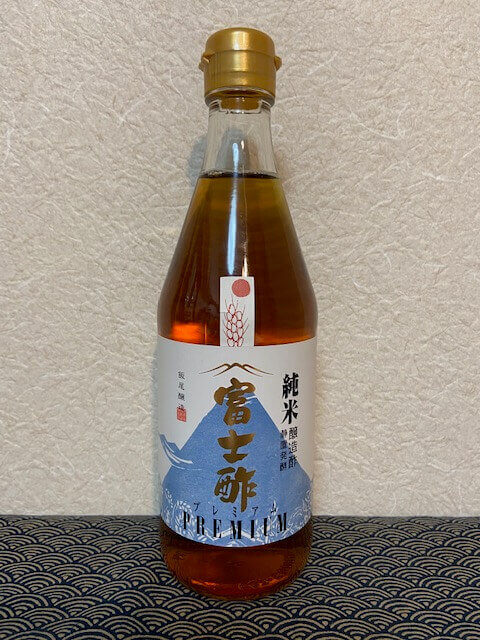 The product called Akazu Premium (赤酢プレミアム) is a vinegar that has been aged for over 16 years, made from lees. This vinegar is so rare that it is reserved for professional sushi chefs and other chefs and is not available in stores. Most sushi restaurants that can use this vinegar to its full potential, really advertise their aged toppings. Sushi toppings that have been aged to their limit also maximize the umami. If rice vinegar is added to a matured topping, the sushi rice becomes as light as white rice. Akazu has an amino acid content of 200 milligrams per 100 grams of rice, which is said to be double that of rice vinegar and it is a vinegar that makes aged toppings even more delicious. Restaurants that use this include Sushi Kimura, Jukusei sushi Yorozu and others that are known for their aged sushi.
The product called Akazu Premium (赤酢プレミアム) is a vinegar that has been aged for over 16 years, made from lees. This vinegar is so rare that it is reserved for professional sushi chefs and other chefs and is not available in stores. Most sushi restaurants that can use this vinegar to its full potential, really advertise their aged toppings. Sushi toppings that have been aged to their limit also maximize the umami. If rice vinegar is added to a matured topping, the sushi rice becomes as light as white rice. Akazu has an amino acid content of 200 milligrams per 100 grams of rice, which is said to be double that of rice vinegar and it is a vinegar that makes aged toppings even more delicious. Restaurants that use this include Sushi Kimura, Jukusei sushi Yorozu and others that are known for their aged sushi.
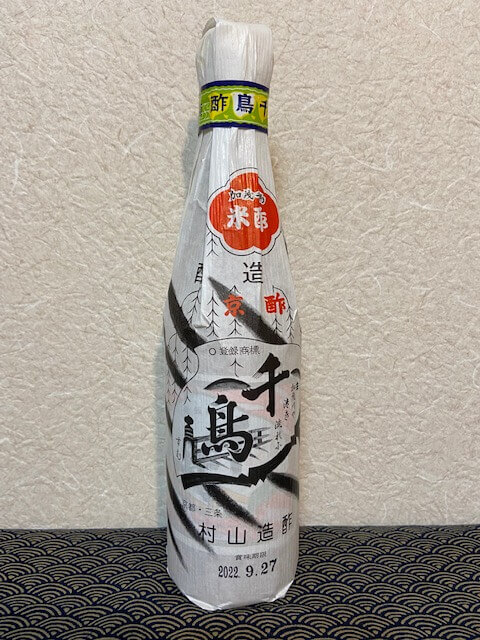 Murayama Zousu is extremely popular among long-established Japanese restaurants in Kyoto. Vinegar has been manufactured here since around 1720. The product name Chidorisu (千鳥酢) is definitely a mellow vinegar. The foundation of Japanese food is to bring out the umami of dashi and ingredients, and the vinegar should not be emphasized. This implies that it vinegar should complement the sushi topping. There are sushi restaurants even in Kanto that go out of their way to use Chidorisu despite having access to Yokoi Vinegar and Kisaichi Vinegar.
Murayama Zousu is extremely popular among long-established Japanese restaurants in Kyoto. Vinegar has been manufactured here since around 1720. The product name Chidorisu (千鳥酢) is definitely a mellow vinegar. The foundation of Japanese food is to bring out the umami of dashi and ingredients, and the vinegar should not be emphasized. This implies that it vinegar should complement the sushi topping. There are sushi restaurants even in Kanto that go out of their way to use Chidorisu despite having access to Yokoi Vinegar and Kisaichi Vinegar.
The last product to introduce is Uchibori Vinegar. This is a long-established vinegar maker founded in 1876. Vinegar must be supplied in high volume at low prices. In a way, this means compromising quality. However, the manufacturers pursue the ideal of producing large quantities at low prices without changing the quality. Mizkan and Yokoi Vinegar are by far the most commonly used at sushi restaurants, but there are also hidden fans of Uchibori Vinegar.
In summary, there is apparently not one correct answer, just as there are many soy sauces and types of rice to choose from.
Related contents:
What type of vinegar do sushi restaurants use?
How is the taste of vinegar determined?
Share this article